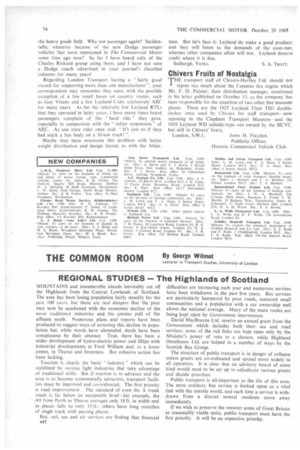THE COMMON ROOM
Page 76

If you've noticed an error in this article please click here to report it so we can fix it.
By George Wilmot
Lecturer in Transport Studies, University of London
REGIONAL STUDIES — The Highlands of Scotland
MOUNTAINS and innumerable islands inevitably cut off the Highlands from the Central Lowlands of Scotland. The area has been losing population fairly steadily for the past 100 years, but there are real dangers that the pace may now be quickened with the economic decline of the more traditional industries and the greater pull of the affluent south. Numerous plans and reports have been produced to suggest ways of arresting this decline in population but, while words have abounded, deeds have been conspicuous by their absence. True, there has been a wider development of hydro-electric power and fillips with industrial developments at Ford William and, to a lesser extent, in Thurso and Inverness. But cohesive action has been lacking.
Tourism is clearly the basic " industry" which can be stabilized by various light industries that take advantage of traditional skills. But if tourism is to advance and the area is to become economically attractive, transport facilities must be improved and co-ordinated. The first priority is road improvement. The standard of even the A trunk roads is far below an acceptable level—for example, the A9 from Perth to Thurso averages only 18 ft. in width and in places falls to only 15 ft.: others have long stretches of single track with passing places.
Bus, rail, sea and air services are finding that financial n42 difficulties are increasing each year and numerous services have been withdrawn in the past five years. Bus services are particularly hampered by poor roads, scattered small communities and a population with a car ownership well above the national average. Many of the main routes are being kept open by Government intervention.
David MacBrayne Ltd. receive an annual grant from the Government which includes both their sea and road services; some of the rail links are kept open only by the Minister's power of veto to a closure, while Highland Omnibuses Ltd. are helped in a number of ways by the Scottish Bus Group.
The structure of public transport is in danger of collapse unless grants are co-ordinated and spread more widely to all operators. It is clear that an advisory board of some kind would need to be set up to adjudicate various grants and decide priorities.
Public transport is all-important to the life of this area. The most ordinary bus service is looked upon as a vital link with the outside world, and each time a service is withdrawn from a district, several residents move away immediately.
If we wish to preserve the remoter areas of Great Britain as reasonably viable units, public transport must have the first priority. It will be an expensive priority.




















































































































